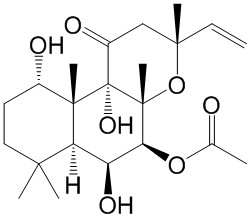Home
Products
Forskolin



| Product Name | Forskolin |
| Price: | $46 / 20mg |
| Catalog No.: | CN08734 |
| CAS No.: | 66575-29-9 |
| Molecular Formula: | C22H34O7 |
| Molecular Weight: | 410.50 g/mol |
| Purity: | >=98% |
| Type of Compound: | Diterpenoids |
| Physical Desc.: | White powder |
| Source: | The herbs of Coleus forskohlii |
| Solvent: | Chloroform, Dichloromethane, Ethyl Acetate, DMSO, Acetone, etc. |
| SMILES: | C=CC1(C)CC(=O)C2(C(O1)(C)C(OC(=O)C)C(C1C2(C)C(O)CCC1(C)C)O)O |
| Contact us | |
|---|---|
| First Name: | |
| Last Name: | |
| E-mail: | |
| Question: | |
| Description | Forskolin is a potent adenylate cyclase activator, with IC50 and EC50 of 41 nM and 0.5 μM for type I adenylyl cyclase, respectively. |
| Target | IC50: 41 nM (Adenylyl cyclase)[1] EC50: 0.5 μM (Adenylyl cyclase)[1] |
| In Vitro | Forskolin (Fsk) is a naturally occurring diterpene isolated from Coleus forskholii, directly activates adenylyl cyclase (AC) through its catalytic subunit to increase intracellular levels of cyclic adenosine monophosphate (cAMP)[1]. Forskolin (Fsk) affects the proliferation of the human T-cell lines such as Kit 225 and MT-2. Forskolin treatment inhibits the proliferation of both Kit 225 and MT-2 cells in a dose-dependent manner with an IC50 equal to ~5 μM Fsk. Forskolin treatment (10-100 μM) increases cAMPi levels ~5- to 20-fold above basal levels, which reache maximum levels between 50-100 μM Forskolin[2]. |
| In Vivo | The Forskolin (Fsk)-treated Mrp4-/- mice shows an increased number of Ki67-positive and cleaved caspase 3-positive ECs, a significant decrease in the amount of pericyte coverage, and a reduced number of empty sleeves. In pups exposed to hyperoxia (75% oxygen) from P7 to P12, the Mrp4-/- mice shows a significant increase in the unvascularized retinal area[3]. The average blood glucose in the healthy rat group is 102.12±1.94 mg/dL, 101.25±3.56 for control group and 103±2.08 in forskolin group. The data shows that glucose levels at the end of the study are lower in forskolin group, with a significant difference according to the statistical tests applied (p=0.03)[4]. |
| Cell Assay | Quiescent Kit 225 or MT-2 cells are seeded into 96-well plates at 5×104 cells per well. Cells are then pretreated for 1 h with 1% DMSO (vehicle) or Forskolin at 1, 5, 10, 25, 50, and 100 μMconcentrations. The cells are stimulated with IL-2 and cultured for an additional 20 h at 37°C. Control cells are treated with 1% DMSO for 20 h. During the final 4 h of incubation, the cells are pulsed with [3H]thymidine at a concentration of 0.5 μCi/200 μL. Cells are harvested onto fiberglass filters and analyzed using liquid scintillation counting[2]. |
| Animal Admin | Mice[3] C57BL/6J mice are used. Mrp4-knockout mice, which are established and repeatedly backcrossed to the C57BL/6J mice. Forskolin is injected intraperitoneally into neonatal mice at postnatal days 4 (P4) and 5 (P5). Mice injected with DMSO serve as the controls. The treated mice are euthanized at P6, and their retinas are isolated for whole-mount immunohistochemistry (IHC). The effect of different concentrations of Forskolin on the survival rate and retinal vasculature is first tested, and the optimal concentration is determined, 1.0 μg/50 μL (0.3 mg/kg) at P4 and 1.5 μg/50 μL (0.5 mg/kg) at P5, used to compare the retinal vascular phenotypes between WT mice and Mrp4-deficient mice. Rats[4] Male Wistar rats, aged 10-14 weeks old, with a mean weight of 300 g±50 g, are divided into four groups; 19 are experimentally induced to develop diabetes, and 8 are maintained in a healthy condition. Both diabetic and healthy rats receive no Forskolin (control), or 6 mg/kg per day of Forskolin, administered orally for 8 weeks. Blood glucose levels are determined in each group before and after Forskolin treatment. The diabetic rats are tested two weeks after confirming the presence of diabetes (three weeks after the induction) and after eight weeks of the designated treatment. |
| Density | 1.2±0.1 g/cm3 |
| Boiling Point | 519.9±50.0 °C at 760 mmHg |
| Flash Point | 171.8±23.6 °C |
| Exact Mass | 410.230438 |
| PSA | 113.29000 |
| LogP | 3.40 |
| Vapour Pressure | 0.0±3.1 mmHg at 25°C |